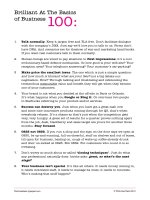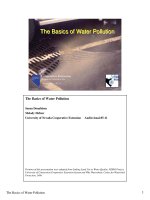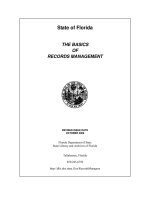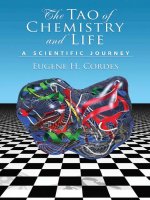The basics of chemistry
Bạn đang xem bản rút gọn của tài liệu. Xem và tải ngay bản đầy đủ của tài liệu tại đây (6.33 MB, 392 trang )
The Basics of Chemistry
Richard Myers
GREENWOOD PRESS
Uploaded by
Gilang Design
Ebook
Bumb.in ebook download (Free Ebooks &
Tutorials) is a free ebooks links library where
you can find and download free books in
almost any category without registering.
For More Free Ebooks
& Tutorials Visit
The Basics of Chemistry
Richard Myers
GREENWOOD PRESS
The Basics of Chemistry
The Basics of Chemistry
Richard Myers
Basics of the Hard Sciences
Robert E. Krebs, Series Editor
GREENWOOD PRESS
Westport, Connecticut • London
Library of Congress Cataloging-in-Publication Data
Myers, Richard, 1951–
The Basics of chemistry / Richard Myers.
p. cm.––(Basics of the hard sciences)
Includes bibliographical references and index.
ISBN 0–313–31664–3 (alk. paper)
1. Chemistry. I. Title. II. Series.
QD33.2.2.M94 2003
540––dc21
2002028436
British Library Cataloging in Publication Data is available.
Copyright © 2003 by Richard Myers
All rights reserved. No portion of this book may be
reproduced, by any process or technique, without the
express written consent of the publisher.
Library of Congress Catalog Card Number: 2002028436
ISBN: 0–313–31664–3
First published in 2003
Greenwood Press, 88 Post Road West, Westport, CT 06881
An imprint of Greenwood Publishing Group, Inc.
www.greenwood.com
Printed in the United States of America
The paper used in this book complies with the
Permanent Paper Standard issued by the National
Information Standards Organization (Z39.48–1984).
10 9 8 7 6 5 4 3 2 1
Every reasonable effort has been made to trace the owners of copyrighted materials in this book, but in some
instances this has proven impossible. The author and publisher will be glad to receive information leading to
more complete acknowledgments in subsequent printings of the book and in the meantime extend their
apologies for any omissions.
To Chris.
For all your support and companionship during our thirty years.
Contents
Preface
Acknowledgments
xiii
xv
Chapter 1
Introduction: Chemistry and Its Divisions
Introduction
The Scientific Enterprise
What Is Chemistry?
Divisions of Chemistry
1
1
2
3
4
Chapter 2
A Brief History of Chemistry
Introduction
Early History
Greek Science
Alchemy
Chemistry in the Middle Ages
7
7
7
9
11
13
Chapter 3
The Birth of Modern Chemistry
Introduction
The Beginnings of Modern Chemistry
The Phlogiston Theory
Pneumatic Chemistry
Lavoisier
17
17
17
19
20
25
Chapter 4
The Atom
Introduction
The Law of Definite Proportions
Dalton and the Birth of the Atomic Theory
Gay-Lussac and Avogadro’s Hypothesis
The Divisible Atom
Atomic Structure
31
31
31
33
34
35
38
viii
Contents
Quantum Mechanics
A Modern View of the Atom
Atomic Mass, Atomic Numbers, and Isotopes
Ions
Summary
40
44
45
45
46
Chapter 5
Atoms Combined
Introduction
Mixtures, Compounds, and Molecules
Naming Elements
Naming Compounds
Writing Chemical Formulas
Chemical Reactions
Types of Reactions
From Molecules to Moles
49
49
49
50
51
54
54
55
56
Chapter 6
Elements and the Periodic Table
Introduction
Discovery of the Elements
The Modern Periodic Table
The Main Group Elements
d and f Block Elements
Metals, Metalloids, and Nonmetals
Periodic Problems
Summary
61
61
61
64
64
67
67
67
69
Chapter 7
Chemical Bonding
Introduction and History
Dot Formulas, the Octet Rule, and Ionic Bonds
Covalent Bonds
Electronegativity and the Polar Covalent Bond
Polar Molecules and Hydrogen Bonds
Bond Energies
The Metallic Bond
Bonding and Molecular Geometry
Modern Bonding Theory
71
71
74
76
76
78
79
80
80
82
Chapter 8
Intermolecular Forces and the Solid and Liquid States
Introduction
Characteristics of Solids, Liquids, and Gases
Intermolecular Forces
Crystalline Solids
Amorphous Solids
Liquids
Material Science
85
85
86
86
90
92
93
95
Contents
ix
Chapter 9
Gases
Introduction
Pressure
The Gas Laws
The Ideal Gas Law
Partial Pressure and Vapor Pressure
Applications of the Gas Laws
99
99
99
102
106
107
109
Chapter 10
Phase Changes and Thermochemistry
Introduction
Changes of State
Energy and Phase Changes
Heating Curves
Calorimetry
Heat of Reaction
Applications of Heat of Reactions
113
113
113
113
115
118
120
122
Chapter 11
Solutions
Introduction
The Solution Process
Electrolytes
Concentration of Solutions
Solubility of Gases
Colligative Properties
Reactions of Solutions
Colloids and Suspensions
125
125
126
128
129
130
131
134
136
Chapter 12
Kinetics and Equilibrium
Introduction
Reaction Rates
The Collision Theory
Factors Affecting Reaction Rates
Reaction Mechanisms and Catalysis
Chemical Equilibrium
Le Châtelier’s Principle
The Equilibrium Constant
Ammonia and the Haber Process
139
139
139
140
142
144
147
149
151
152
Chapter 13
Acids and Bases
Introduction and History
Chemical Definitions of Acids and Bases
Strengths of Acids and Bases
Acid Concentration
pH and pOH
Neutralization Reactions
Buffers
Summary
155
155
156
159
160
161
163
166
169
x
Contents
Chapter 14
Electrochemistry
Introduction
History
Oxidation and Reduction
Oxidation Numbers
Electrochemical Cells
Electrolysis
Batteries
Corrosion
Electroplating
Commercial Applications and Electrorefining
Summary
171
171
171
176
177
179
184
185
189
190
191
193
Chapter 15
Organic Chemistry
Introduction and History
Organic Compounds
Aliphatic Hydrocarbons
Aromatic Hydrocarbons––Benzene
Functional Groups and Organic Families
Petroleum
Organic Products
Summary
195
195
198
199
205
207
216
219
220
Chapter 16
Biochemistry
Introduction
Carbohydrates
Lipids
Proteins
Nucleic Acids
Biotechnology
221
221
221
226
229
233
236
Chapter 17
Nuclear Chemistry
Introduction
Nuclear Stability and Radioactivity
Radioactive Decay and Nuclear Reactions
Half-Life and Radiometric Dating
Nuclear Binding Energy––Fission and Fusion
Fusion and Stellar Evolution
Transmutation
Nuclear Medicine
Radiation Units and Detection
Biological Effects of Radiation
Summary
241
241
241
243
244
246
251
252
254
255
257
259
Contents
xi
Chapter 18
Environmental Chemistry
Introduction
Stratospheric Ozone Depletion
Acid Rain
The Greenhouse Effect
Water Quality
Air Pollution
Pesticides
Summary
261
261
262
266
270
273
278
281
287
Chapter 19
The Chemical Industry
Introduction
Acids and Alkalis
Explosives
Synthetic Dyes
Synthetic Fibers and Plastics
Synthetic Rubber
Petrochemicals
Industry Histories
Summary
289
289
290
292
293
297
299
301
302
307
Chapter 20
Chemistry Experiments
Introduction
The Scientific Method
Chemistry Experimentation
Chemical Activities
309
309
309
312
313
Chapter 21
A Future in Chemistry
Introduction
Chemist’s Job Description and Training
Careers in Chemistry
Professional Development and the American Chemical Society
327
327
327
330
332
Glossary
335
Brief Timeline of Chemistry
351
Nobel Laureates in Chemistry
355
Table of the Elements
361
Selected Bibliography
363
Author Index
365
Subject Index
369
Preface
Perhaps not everyone is a student of chemistry in the formal sense of being enrolled in a chemistry course, but everyone uses chemistry on a daily basis. Every time a package label is read
to check ingredients, food is tasted to determine whether it needs spices added, or mixtures are
prepared, chemistry is practiced. Without even knowing it, all of us have accumulated a basic
understanding of chemistry by observing the world around us. Observations such as salt melting ice, milk souring, leaves turning color, iron rusting, and wood burning demonstrate that
changes are constantly occurring. Because chemistry is essentially the study of change and
we are constantly observing these changes, we all are students of chemistry.
The Basics of Chemistry is written for students beginning a formal study of chemistry. These
readers are primarily high school and college students enrolled in their first chemistry course.
In addition to these students, individuals who are not enrolled in a chemistry course but would
like a general overview of the subject should find this book helpful. Teachers of all grades may
use The Basics of Chemistry as a general reference on the subject.
The Basics of Chemistry is a general reference book that presents the basic scientific concepts of chemistry in addition to providing information on several related subjects. Chapters
progress through several areas. The first several chapters focus on chemistry’s roots as a modern science. Although the first chapters focus heavily on the historical development of chemistry, most of the other chapters give a historical overview of the chapter’s content. The heart
of this book is devoted to explaining basic chemistry concepts. In these chapters, I review the
content found in a beginning chemistry course. Subjects such as nomenclature, chemical bonding, acids and bases, equilibrium, kinetics, solutions, and gases are covered. Building on these
general concepts, the chapters that follow explore several subdivisions of chemistry and present additional concepts especially important in these subdivisions. Chapters on organic chemistry, biochemistry, electrochemistry, nuclear chemistry, and environmental chemistry are
included. Chapter 19 presents an overview of the chemical industry and includes information
on industrial chemistry. Chapter 20 presents the experimental method and twenty chemistry
activities. The final chapter provides an overview of the chemistry profession, possible careers
in chemistry, and chemical education.
This book is enhanced by other features. It includes a glossary of chemistry terms. Glossary
terms are typed in boldface when they first appear in the text. The year of birth and year of
xiv
Preface
death of important individuals are given in parentheses following the first appearance of a person’s name. Ample illustrations, tables, and analogies are used to clarify basic chemistry concepts and highlight important chemical information. The chapter on the chemistry industry
provides background information on the founding of a number of well-known chemical companies.
The most difficult task in writing a book called The Basics of Chemistry is deciding what
material to include in the book. What may be “the basics” for one person may not be for
another. Rather than present a list of basic facts, I present chemistry from a broad perspective. An introductory book on such a broad subject should give the student a glimpse of the
discipline, provide basic concepts and information, and offer a foundation for further study.
In this respect, an introductory text is like wiping the moisture from a fogged window. Many
objects become clear through the transparent opening, but the rest of the glass remains foggy.
Objects viewed through the fog are unclear. Even after wiping away all of the moisture, only
a small portion of the outside world can be seen. My hope is that The Basics of Chemistry provides the student with a small, cleared opening into the world of chemistry. Once a glimpse
is gained through this opening, the student can continue to enlarge the opening. After clearing the window, then it’s time to move to the next window.
Acknowledgments
Many individuals helped in the preparations of this book. Jennifer Rochelle provided timely
typing whenever needed. Sean Tape and the team at Impressions Book and Journal Services
did an exceptional job of editing the manuscript. Greenwood Press initiated this book as part
of a series of general reference books in the sciences. I would like to thank the staff at Greenwood for the opportunity to write this book. Greenwood’s Debby Adams provided guidance
and a firm hand at the wheel as she shepherded the project through production. Rae Déjur’s
illustrations demonstrate that one picture is truly worth a thousand words, and in some cases
much more. A special thanks goes to Robert Krebs who mentored me throughout this project
by providing encouragement and valuable feedback.
A number of chemical structures were drawn by ACD/ChemSketch version 4.55 developed
by Advanced Chemical Development, Inc. For more information please check the ACD Web
site at www.acdlabs.com.
1
Introduction: Chemistry and Its Divisions
Introduction
What do you think of when the word “chemistry” is mentioned? For many, chemistry
projects images of a crazed scientist dressed
in a white lab coat mixing a bubbly, spewing, stinking concoction. The absentminded
professor is the classic stereotype of a
chemist. The original Disney movie (The
Absentminded Professor) released in 1961
tells the story of a chemistry professor who
accidentally creates “flubber,” a substance
with gravity-defying levitative properties. A
few years later in 1965, chemists produced
what seemed to be real-world flubber. It was
and continues to be marketed as the superball®. A more modern version of a chemist
is FBI agent Stanley Goodspeed portrayed
by Nicholas Cage in the movie The Rock.
Goodspeed is the FBI’s point man on chemical weapons. In the movie, he secretly penetrates Alcatraz Island, which is held by a
group of ultrapatriotic military extremists.
Once on Alcatraz, he must beat a deadline
to disarm rockets loaded with a deadly
chemical weapon aimed at San Francisco.
Hollywood’s portrayal of chemistry
stretches the imagination, but probably no
more than that of a person living at the
beginning of the twentieth century who
could foresee life at the start of the twentyfirst century. A quick look around is all it
takes to see how chemistry has transformed
our modern world. The plastic disposable
ballpoint pen I use to write with has been in
existence only since 1950. Your clothes may
be made of natural materials, but chances
are you are wearing plenty of synthetics
such as nylon, dacron, and polyurethane.
You drink tap water that was chlorinated in
the last few hours and will be chlorinated
again at the treatment plant before it continues its journey through the water cycle. Our
vehicles burn refined oil, and catalytic converters reduce the amount of pollution
entering the atmosphere. Just opening a
medicine cabinet gives ample evidence of
the advances in chemistry during the last
one hundred years. Cosmetics, soaps, medicines, and cleansers are all products of the
modern chemical industry.
Much of the twentieth century has been
characterized by the use and abuse of chemistry. There is no doubt that advances in
chemistry and chemical technology have
improved and extended life, but there is also
2
Introduction: Chemistry and Its Divisions
a price for living in a modern chemical society. Environmental costs such as ozone
depletion, acid rain, water pollution, air pollution, and hazardous wastes are part of the
price we pay for the benefits of living in a
chemical society. New drugs and medicines
have eradicated disease, and advances in
chemistry have allowed possible fertilizers
and other agricultural advances to increase
the world’s food supply. These developments have led to a booming world population currently at six billion and growing.
To sustain a growing world population of
over six billion means converting raw materials into products. In recent years, we have
recognized the need to “reduce, reuse, and
recycle.” We know that one of the fundamental principles of chemistry is that matter is not created or destroyed, and chemical
processes themselves play a major role in
recovering raw materials from used products. Many items once considered waste are
now recycled supplementing raw materials
obtained from the Earth. As more countries
such as China develop their industrial infrastructure, the demand for energy and material resources is bound to increase.
The laws of thermodynamics tell us that
the conversion of raw materials into finished
goods requires energy and ultimately results
in an ever-increasing amount of heat
released into the environment. This waste
heat is accompanied by carbon dioxide produced from the burning of fossil fuels.
There seems to be a consensus among scientists that our planet’s temperature is
increasing due to the greenhouse effect,
although a minority of scientists do not
believe that our planet’s temperature is
increasing. Many scientists also feel that
increased temperatures are part of natural
fluctuations and that humans have little
impact on the recent trend of elevated
global temperatures. International efforts
are now underway to curb carbon dioxide
emissions worldwide, such as revegetation,
curbing slash and burn practices, and sequestering carbon dioxide in the sea, are
stalled by disagreements between developed
and underdeveloped countries, as well as
Europe and the United States.
The Scientific Enterprise
So how do we strike a balance between
the benefits of better living through chemistry and the costs associated with this
lifestyle? One answer to this question is
knowledge. Greater knowledge equips us
with the tools to make informed decisions
when we live in a free democratic society.
Chemical knowledge is based on a long history of chemical research. The methodological procedure to attain scientific knowledge
is often defined as the scientific method. The
classical view of the scientific method presents science as a neat step-by-step procedure starting with formulating a question,
posing a hypothesis, performing a controlled experiment to address the hypothesis, and drawing conclusions from the
experiment. Although this view is accurate
in an idealized sense, in reality, true science
is filled with pitfalls, blind alleys, dead ends,
false starts, fortuitous accidents, and human
idiosyncrasies. Books on science often give
the impression that science proceeds in a
linear, uniform fashion. More often, scientific progress follows a circuitous route with
periods of accelerated discoveries and long,
relatively dormant periods.
The theories and facts we cling to today
are only an experiment away from revision.
As you read these words, chemical research
is occurring in thousands of labs across the
globe. The modern scientific enterprise is
vastly different from that of the quintessential scientist working in isolation in a small
laboratory. Modern research is characterized
by research teams led by scientists who spe-
Introduction: Chemistry and Its Divisions
cialize in very specific fields. Teamwork is
essential as research teams across the world
attempt to answer fundamental questions.
These teams work both cooperatively and
competitively with other teams working on
similar problems. Work is continually
reviewed, critiqued, revised, and published
in scientific journals. The advent of the
Internet has led to both a wider audience
and a faster distribution for research results.
Much of today’s research takes place in universities and is supported by governmental
agencies that distribute millions of dollars
annually to those teams whose work is
deemed worthy of support. In addition to
this research, numerous private companies
operate their own private research labs to
develop products and processes to give them
an advantage over their competitors. Chemical research is both basic and applied. Basic
research addresses the fundamental laws of
nature and is undertaken to advance the theoretical foundation of chemistry. Applied
research is performed with a specific application in mind, for example, better products
or to improve the quality of life. Research
should not be viewed in terms of a basic or
applied research dichotomy. Most research
contains elements of both basic and applied
research.
As new knowledge is gained through
research, additional questions are raised and
new areas of research are continually
exposed in a neverending process. Because
knowledge is power, as we embark on the
twenty-first century, a knowledge of chemistry is essential to shape a sustainable
future. Chemical knowledge may lead to a
simple decision to recycle or choose one
product over another. Perhaps this knowledge helps you make a decision to undertake a certain medical treatment or vote for
or against an issue. Chemical knowledge
can help guide you in any number of choices
you make today. More important, this
3
knowledge will help you with decisions
concerning novel areas we can only imagine
but know will develop as the twenty-first
century unfolds.
What Is Chemistry?
Chemistry is the branch of science that
deals with the composition and structure of
matter and the changes that matter undergoes. Matter is anything that has mass and
occupies spaces, which means just about
anything you consider. This book, your body
and the air you breathe are all examples of
matter. Matter is simply the stuff that makes
up our universe.
Chemistry, like all branches of science,
is a method that attempts to simplify and
organize. Every object we might consider is
a separate piece of matter, and matter can be
classified in any number of ways. One simple classification scheme for matter is based
on the three states of matter: solid, liquid,
and gas (four if we include plasma).
Another classification scheme, and one that
is fundamental to chemistry, is classifying
matter by chemical composition. Rather
than speaking of water as a form of matter,
we can speak of water composed of approximately 11% hydrogen and 89% oxygen by
mass. Similarly, air is a mixture of matter
containing approximately 78% nitrogen,
21% oxygen, a little less than 1% argon by
volume, and an assortment of other gases in
small percentages.
Much of the history of chemistry has
concerned itself with determining the ultimate composition of matter. The Greeks
considered all matter to be composed of different combinations of earth, air, fire, and
water. It is only during the last two hundred
years that the modern idea of chemical elements developed and only in the last one
hundred years that we have determined that
elements themselves are composed of
4
Introduction: Chemistry and Its Divisions
protons, neutrons, and electrons. Hence, we
can think of all matter to be composed of 91
naturally occurring elements, and protons,
neutrons, and electrons are the building
blocks that make up the elements. Chemistry not only deals with the composition of
matter, but how the pieces of matter fit
together, that is, the structure of matter. The
structure of matter can have a major impact
on its properties. For example, carbon can
exist as a two-dimensional flat structure, or
a soft, black graphite, or in the pyramidal
three-dimensional tetrahedron shape we
know as diamond (Figure 1.1).
So far, we have noted that chemistry
involves the composition and structure of
matter. But beyond knowing what the composition of matter is and how the pieces fit
together, chemistry is about how matter
changes from one substance to another.
When we refer to chemical change, we mean
that the composition of matter has changed.
A chemical change occurs when a substance
or substances change into other substances.
Figure 1.1
Diamond and Graphite Structure
(Rae Déjur)
For example, when hydrogen and oxygen are
brought together under the right conditions,
they can combine and change into water.
When the carbon in paper reacts with oxygen
in the air during combustion, it changes into
carbon dioxide. The key when considering
whether a chemical change has taken place is
to ask the question: do I end up with something different from what I started? Chemical changes result in the production of
something entirely different from the original substances. The element sodium is a
highly reactive metal that reacts violently
with water. Chlorine is a highly toxic gas. Yet,
put sodium and chlorine together under the
right conditions and you have table salt.
Not all changes are necessarily chemical changes. Changes may also be physical
changes. When water changes from ice to
liquid to steam, change has certainly taken
place, but not a chemical change. Water in
its solid ice state is H2O. After melting and
vaporizing, it is still H2O. The substance
water has not changed. The physical state
has changed, but not the substance. Similarly, when sugar dissolves in water, no
chemical change takes place. We start with
sugar and water and end with sugar and
water. Again, only a physical change occurs,
because we still have sugar and water after
the sugar dissolves. To summarize, chemistry can be thought of as the science of the
study of matter: what matter is made of, how
it is made, and the changes in matter from
one substance into another.
Divisions of Chemistry
The definition given in the last section is
very general. Although all chemists are
involved in the study of matter, the field is so
broad that it helps to divide chemistry into
divisions. These divisions characterize different aspects of the study of chemistry
using some common feature. Chemistry may
Introduction: Chemistry and Its Divisions
be divided into the two very large divisions
of inorganic and organic chemistry.
Inorganic chemistry involves the
study of the chemical elements, their compounds, and reactions excluding those that
contain carbon as the principal element.
Organic chemistry is the study of the
composition and the reaction of carboncontaining compounds. The distinction
between inorganic and organic results from
the days when chemical compounds were
classified according to their origin. Inorganic means not derived from life. Inorganic substances were thought to originate
only from mineral, nonliving sources. Conversely, organic compounds were thought to
have come from living plant or animal
sources. All organic substances contain carbon, and it was once believed that these carbon substances could originate only from a
living source. We know today that many
organic compounds are synthesized from
inorganic, nonliving sources. Some examples include polypropylene, acrylics, and
nylon used in clothing; polystyrene (styrofoam) used for insulation; and ethylene glycol (antifreeze). Even though the original
distinction separating inorganic and organic
does not hold, the terms are still used to
distinguish two broad areas of chemistry.
For our purposes, we can think of organic
chemistry as simply the chemistry of carbon compounds and inorganic chemistry as
the study of all other compounds. It should
be noted, though, that certain carbon compounds, most notably carbon dioxide and
carbonates, are classified as inorganic.
In addition to the large divisions of
organic and inorganic chemistry, several
other large divisions of chemistry exist. Biochemistry is the study of chemical substances
associated with living organisms. Biochemists study the nature of biological substances. The study of DNA, viruses, and
immune systems are examples of biochemi-
5
cal research. Physical chemistry deals with
the structure of matter and how energy affects
matter. Physical chemists are concerned with
the physical characteristics of matter. Areas
of research in physical chemistry might
include how chemicals absorb light or how
much energy is released or absorbed when a
chemical reaction occurs. Closely related to
physical chemistry is the study of nuclear
chemistry. Nuclear chemistry focuses on the
study of atomic nuclei, nuclear fission reactions, and nuclear fusion reactions. The
nucleus is the positive central portion of an
atom composed of positively charged protons
and uncharged neutrons. Fission reactions
involve the physical splitting of heavier elements into smaller elements, and fusion
involves lighter elements physically combining to form heavier elements, for example,
the fusion of hydrogen to form helium. Analytical chemistry deals with techniques used
to identify and quantify the composition of
matter. Analytical chemists, as the name
implies, analyze substances for their content.
An analytical chemist might perform tasks
such as determining the sugar content of a
fruit juice, the amount of pollutant in a water
body, or the purity of a drug. Environmental
chemistry focuses on the occurence of natural and synthetic substances in the environment and their impact on the environment.
The study of the chemistry of pollution is a
major area of concern for environmental
chemists. Problems involving water pollution, air pollution, solid waste, hazardous
materials, and toxic substances involve a
study of environmental chemistry. Each of
the major areas of chemistry mentioned
above, however, are not rigid divisions.
The nature of chemistry is such that the
fields of study in many areas naturally cross
over into other areas. A biochemist naturally
works in the area of organic chemistry, and
an environmental chemist who studies radiation is concerned with nuclear chemistry.
6
Introduction: Chemistry and Its Divisions
Many branches of chemistry exist in conjunction with other areas of science. For
example, the study of the chemistry of rocks
and minerals falls under the category of
geochemistry. The combination of medicine
and chemistry leads to medicinal chemistry.
Other divisions include agricultural chemistry, food chemistry, petroleum chemistry,
soil chemistry, and polymer chemistry.
As chemical knowledge continues to
expand, we are certain to develop new areas
of study in chemistry. Just recently, chemists
have performed simple computer functions
using chemical reactions rather than performing these functions electronically.
Chemical reactions that perform computer
operations bring computers closer to modeling human thought processes. Our thoughts
result from chemical reactions that occur in
our brains. As chemists work at the forefront
of this area of technology and others, new
interdisciplinary areas will certainly develop.
Those new areas add to existing branches of
chemistry and at the same time create new
areas of study.
In the chapters to follow, the basic concepts that guide chemists in their study of
matter are examined. In addition to introducing these basic concepts, the historical
foundation of chemical thought, as well as
new areas of chemical research, are explored. This knowledge is intended to give
the reader a clearer view of the wonderful
world of chemistry that is all around us; and
with this, a foundation to build upon. All
progress by scientists is dependent on the
work of those who precede them. In a letter
to Robert Hooke, Isaac Newton stated, “If I
have seen farther than others, it is because
I was standing on the shoulders of giants.”
The goal of this book is to help you see a
little farther.









